Streamflow Reconstructions Using Tree-Ring Based Paleo Proxies for the Upper Adige River Basin (Italy)
Abstract
:1. Introduction
2. Materials and Methods
2.1. Streamflow
2.2. OWDA scPDSI Data
2.3. Predictor Prescreening Methods
2.4. Reconstruction Methodology
3. Results
4. Discussion
- Adopted the recommendations of [17] in that a 450 km search radius was applicable to capture the regional climate signal when using scPDSI as proxies for streamflow reconstruction. Ref. [15] limited scPDSI cell to those (only) within the Po River Basin watershed. This limitation of scPDSI cells likely contributed to the lower Po River Basin reconstruction skill when compared to the upper ARB reconstruction skill obtained in this study. As displayed in Figure 6, the majority of scPDSI cells available for use in the SLR model are outside the ARB. Additionally, this pattern of scPDSI cells was consistently for the four individual ARB gauge locations (figures not provided). The regional climate signal appears to show scPDSI cells that are generally located west and north of the ARB. Physically, this confirms the generally pattern of moisture in this region (e.g., northern hemisphere) in which storms typically track from west to east. Thus, it is reasonable that the scPDSI cells identified as being “tele-connected” with ARB streamflow would be in the locations identified.
- Obtained gauged streamflow data, while [15] utilized GloFAS-modeled streamflow data. The authors hypothesize the use of gauge data improved the skill of the streamflow reconstruction given that it represents an in-situ, measured data source and, thus, is likely to have fewer uncertainties when compared to GloFAS-modeled streamflow data. While the authors acknowledged that the gauge sites selected in the upper ARB likely have impairments, as stated, the use of this streamflow data was justified based on intercorrelations between the four gauges for the 1980 to 2012 period of record (33 years) exceeding 99% significance for all combinations. Thus, at an annual timescale, the gauges behave similarly and any impairments, primarily associated with small hydropower sites, appear minimal.
- Developed a regional reconstruction in addition to the gauge reconstructions, which was recommended by [17]. We suspect that a regional representation of upper ARB streamflow will better capture a regional climate signal and, thus, provide increased statistical skill. The regional reconstruction resulted in an R2 value of 0.73 which was higher than three of the four individual gauges. The Adige/Etsch (Branzoll) streamflow reconstruction was the only gauge reconstruction to exceed the R2 value of the regional reconstruction and it exceeded it by only 0.01 (e.g., Adige/Etsch—Branzoll R2 value of 0.74).
- We have high confidence in the regional reconstruction of annual upper ARB streamflow given rigorous statistical tests were performed to address concerns of multi-collinearity and over-fitting when using the highly intercorrelated scPDSI proxies.
5. Conclusions
Author Contributions
Funding
Institutional Review Board Statement
Informed Consent Statement
Data Availability Statement
Acknowledgments
Conflicts of Interest
References
- Mastrotheodoros, T.; Pappas, C.; Molnar, P.; Burlando, P.; Manoli, G.; Parajka, J.; Fatichi, S. More green and less blue water in the Alps during warmer summers. Nat. Clim. Chang. 2020, 10, 155–161. [Google Scholar] [CrossRef]
- Puspitarini, H.D.; François, B.; Zaramella, M.; Brown, C.; Borga, M. The impact of glacier shrinkage on energy production from hydropower-solar complementarity in alpine river basins. Sci. Total Environ. 2020, 719, 137488. [Google Scholar] [CrossRef]
- Mallucci, S.; Majone, B.; Bellin, A. Detection and attribution of hydrological changes in a large Alpine river basin. J. Hydrol. 2019, 575, 1214–1229. [Google Scholar] [CrossRef]
- Galletti, A.; Avesani, D.; Bellin, A.; Majone, B. Detailed simulation of storage hydropower systems in large Alpine watersheds. J. Hydrol. 2021, 603, 127125. [Google Scholar] [CrossRef]
- Viviroli, D.; Dürr, H.H.; Messerli, B.; Meybeck, M.; Weingartner, R. Mountains of the world, water towers for humanity: Typology, mapping, and global significance. Water Resour. Res. 2007, 43. [Google Scholar] [CrossRef] [Green Version]
- Bocchiola, D. Long term (1921–2011) hydrological regime of Alpine catchments in Northern Italy. Adv. Water Resour. 2014, 70, 51–64. [Google Scholar] [CrossRef]
- Tuo, Y.; Marcolini, G.; Disse, M.; Chiogna, G. Calibration of snow parameters in SWAT: Comparison of three approaches in the Upper Adige River basin (Italy). Hydrol. Sci. J. 2018, 63, 657–678. [Google Scholar] [CrossRef]
- Gaglio, M.; Aschonitis, V.; Castaldelli, G.; Fano, E.A. Land use intensification rather than land cover change affects regulating services in the mountainous Adige river basin (Italy). Ecosyst. Serv. 2020, 45, 101158. [Google Scholar] [CrossRef]
- Tuo, Y.; Zheng, D.; Disse, M.; Chiogna, G. Evaluation of precipitation input for SWAT modeling in Alpine catchment: A case study in the Adige river basin (Italy). Sci. Total Environ. 2016, 573, 66–82. [Google Scholar] [CrossRef] [Green Version]
- Callegari, M.; Mazzoli, P.; De Gregorio, L.; Notarnicola, C.; Pasolli, L.; Petitta, M.; Pistocchi, A. Seasonal river discharge forecasting using support vector regression: A case study in the Italian Alps. Water 2015, 7, 2494–2515. [Google Scholar] [CrossRef] [Green Version]
- Formetta, G.; Marra, F.; Dallan, E.; Zaramella, M.; Borga, M. Differential orographic impact on sub-hourly, hourly, and daily extreme precipitation. Adv. Water Resour. 2021, 159, 104085. [Google Scholar] [CrossRef]
- Nagy, L.; Grabherr, G.; Körner, C.; Thompson, D.B. (Eds.) Alpine Biodiversity in Europe, 2003rd ed.; Springer Science Business Media: Berlin, Germany, 2012; Volume 167, Softcover reprint (512 pages) of the original 1st ed. [Google Scholar]
- Autorità di bacino del Fiume Adige, A.D.B. Quaderno Sul Bilancio Idrico Superficiale di Primo Livello; Bacino Idrografico Del Fiume Adige: Trento, Italy, 2008. [Google Scholar]
- Chiogna, G.; Majone, B.; Paoli, K.C.; Diamantini, E.; Stella, E.; Mallucci, S.; Bellin, A. A review of hydrological and chemical stressors in the Adige catchment and its ecological status. Sci. Total Environ. 2016, 540, 429–443. [Google Scholar] [CrossRef] [PubMed] [Green Version]
- Obertelli, M. A Data-Driven Approach to Streamflow Reconstruction Using Dendrochronological Data. Politecnico Milano Master Thesis by Marco Obertilli Matr. 2020, p. 899999. Available online: https://www.politesi.polimi.it/handle/10589/154385 (accessed on 1 November 2021).
- Nasreen, S.; Součková, M.; Vargas Godoy, M.R.; Singh, U.; Markonis, Y.; Kumar, R.; Hanel, M. A 500-year runoff reconstruction for European catchments. Earth Syst. Sci. Data Discuss. 2021, 1–29. [Google Scholar] [CrossRef]
- Ho, M.; Lall, U.; Cook, E.R. Can a paleodrought record be used to reconstruct streamflow?: A case study for the Missouri River Basin. Water Resour. Res. 2016, 52, 5195–5212. [Google Scholar] [CrossRef] [Green Version]
- Ho, M.; Lall, U.; Sun, X.; Cook, E.R. Multiscale temporal variability and regional patterns in 555 years of conterminous U.S. streamflow. Water Resour. Res. 2017, 53, 3047–3066. [Google Scholar] [CrossRef]
- Cook, E.R.; Seager, R.; Heim, R.R.; Vose, R.S.; Herweijer, C.; Woodhouse, C. Megadroughts in North America: Placing IPCC projections of hydroclimatic change in a long-term paleoclimate context. J. Quat. Sci. 2010, 25, 48–61. [Google Scholar] [CrossRef] [Green Version]
- Cook, E.R.; Krusic, P.J. The North American Drought Atlas, Lamont-Doherty Earth Observatory and National Science Foundation, N. Y. 2004. Available online: https://iridl.ldeo.columbia.edu/SOURCES/.LDEO/.TRL/.NADA2004/pdsiatlashtml/pdsireadme.html (accessed on 1 November 2021).
- Cook, E.R.; Seager, R.; Kushnir, Y.; Briffa, K.R.; Büntgen, U.; Frank, D.; Krusic, P.J.; Tegel, W.; Van Der Schrier, G.; Andreu-Hayles, L.; et al. Old World megadroughts and pluvials during the Common Era. Sci. Adv. 2015, 1, e1500561. [Google Scholar] [CrossRef] [PubMed] [Green Version]
- Biondi, F.; Waikul, K. DENDROCLIM2002: A C++ program for statistical calibration of climate signals in tree-ring chronologies. Comput. Geosci. 2004, 30, 303–311. [Google Scholar] [CrossRef]
- Vines, M.; Tootle, G.; Terry, L.; Elliott, E.; Corbin, J.; Harley, G.L.; Therrell, M. A Paleo Perspective of Alabama and Florida (USA) Interstate Streamflow. Water 2021, 13, 657. [Google Scholar] [CrossRef]
- Anderson, S.; Ogle, R.; Tootle, G.; Oubeidillah, A. Tree-ring reconstructions of streamflow for the Tennessee Valley. Hydrology 2019, 6, 34. [Google Scholar] [CrossRef] [Green Version]
- Woodhouse, C.A. A 431-Yr reconstruction of Western Colorado snowpack from tree rings. J. Clim. 2003, 16, 1551–1561. [Google Scholar] [CrossRef]
- Garen, D.C. Improved techniques in regression-based streamflow volume forecasting. J. Water Resour. Plan. Manag. 1992, 118, 654–670. [Google Scholar] [CrossRef]
- O’Brien, R.M. A caution regarding rules of thumb for variance inflation factors. Qual. Quant. 2007, 41, 673–690. [Google Scholar] [CrossRef]
- Draper, N.R.; Smith, H. Applied Regression Analysis, 2nd ed.; John Wiley: New York, NY, USA, 1981; p. 736. [Google Scholar]
- Harrigan, S.; Zsoter, E.; Alfieri, L.; Prudhomme, C.; Salamon, P.; Wetterhall, F.; Pappenberger, F. GloFAS-ERA5 operational global river discharge reanalysis 1979—Present. Earth Syst. Sci. Data 2020, 12, 2043–2060. [Google Scholar] [CrossRef]
- Intergovernmental Panel on Climate Change (IPCC) Climate Change 2021, They Physical Basis, Chapter 8 Water Cycle Changes. Available online: https://www.ipcc.ch/report/ar6/wg1/downloads/report/IPCC_AR6_WGI_Chapter_08.pdf (accessed on 1 November 2021).


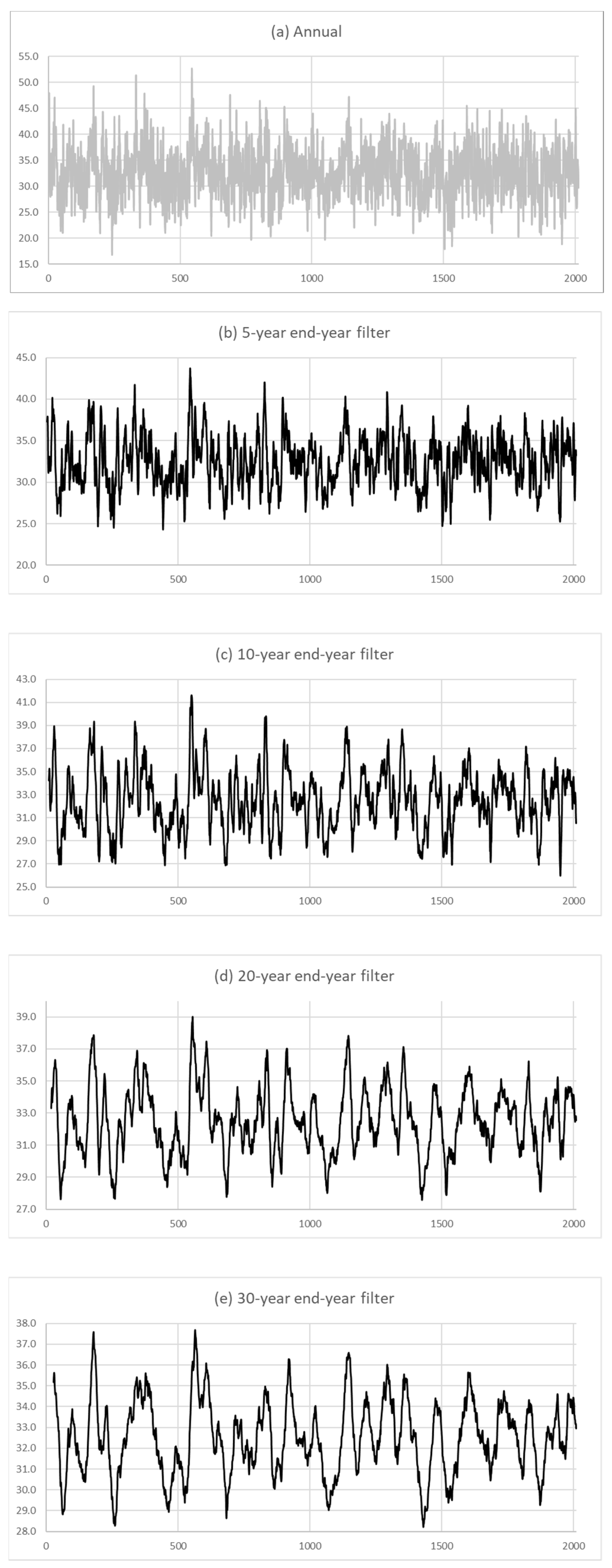
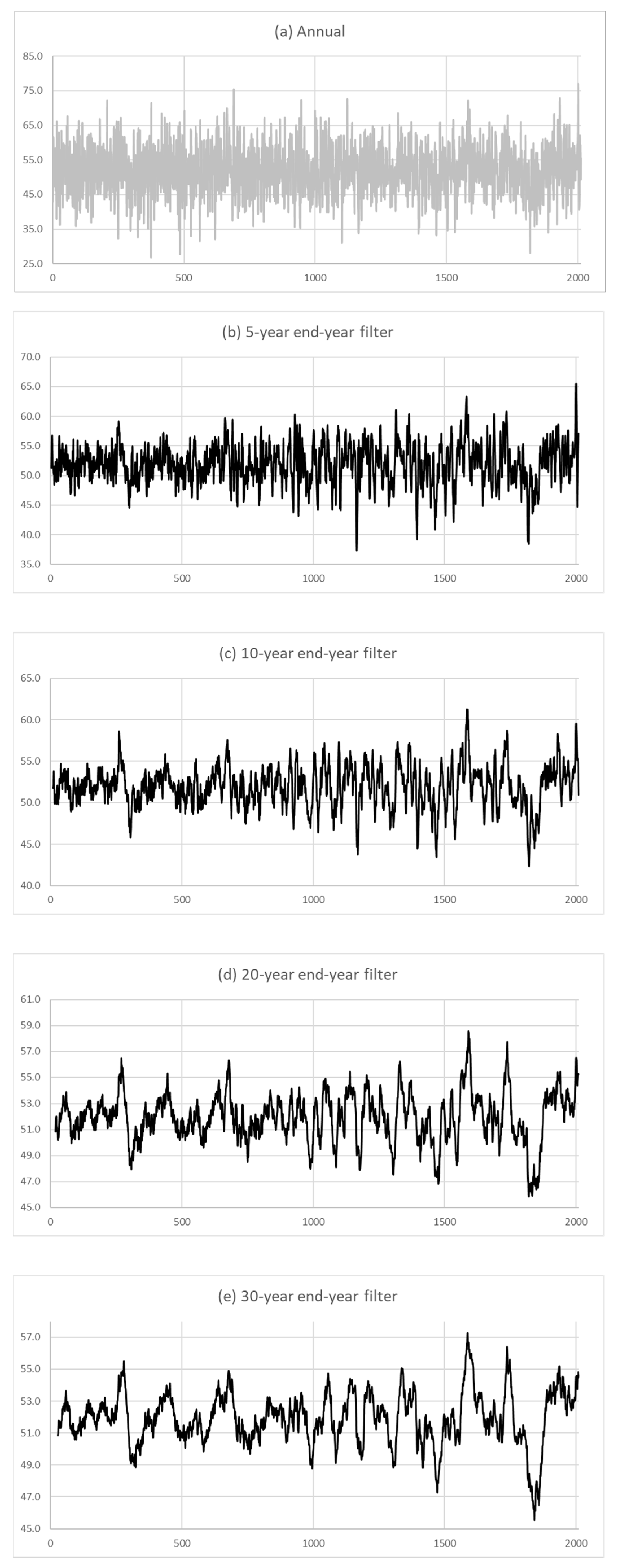
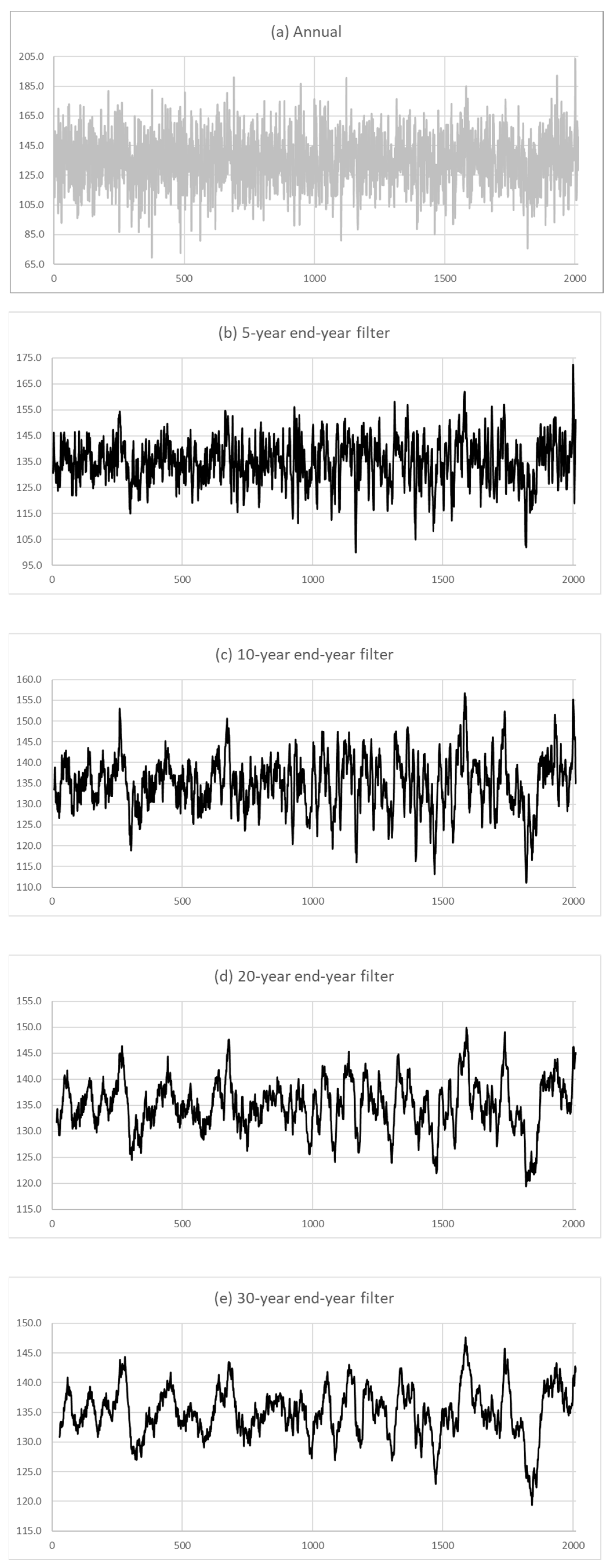

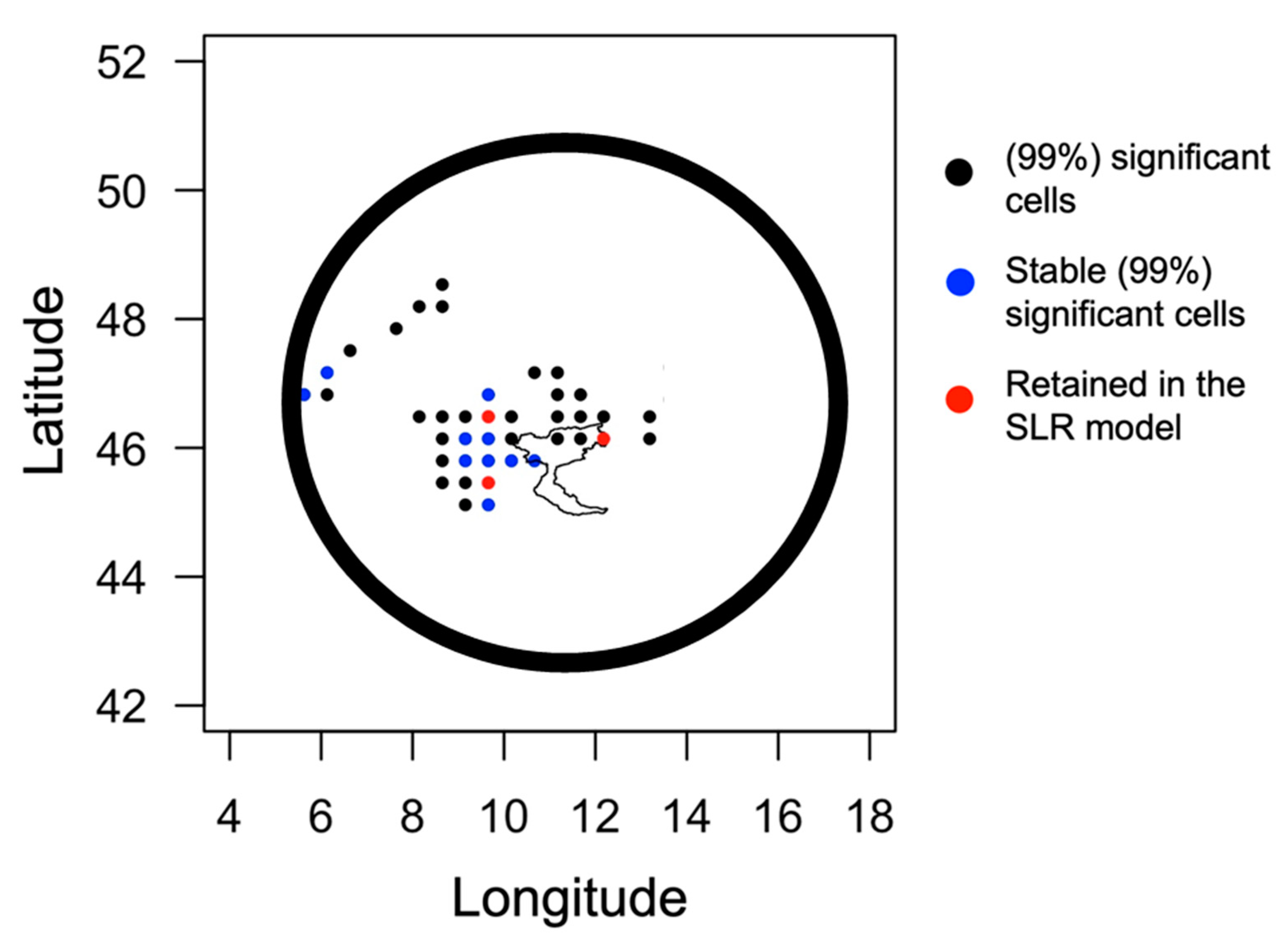
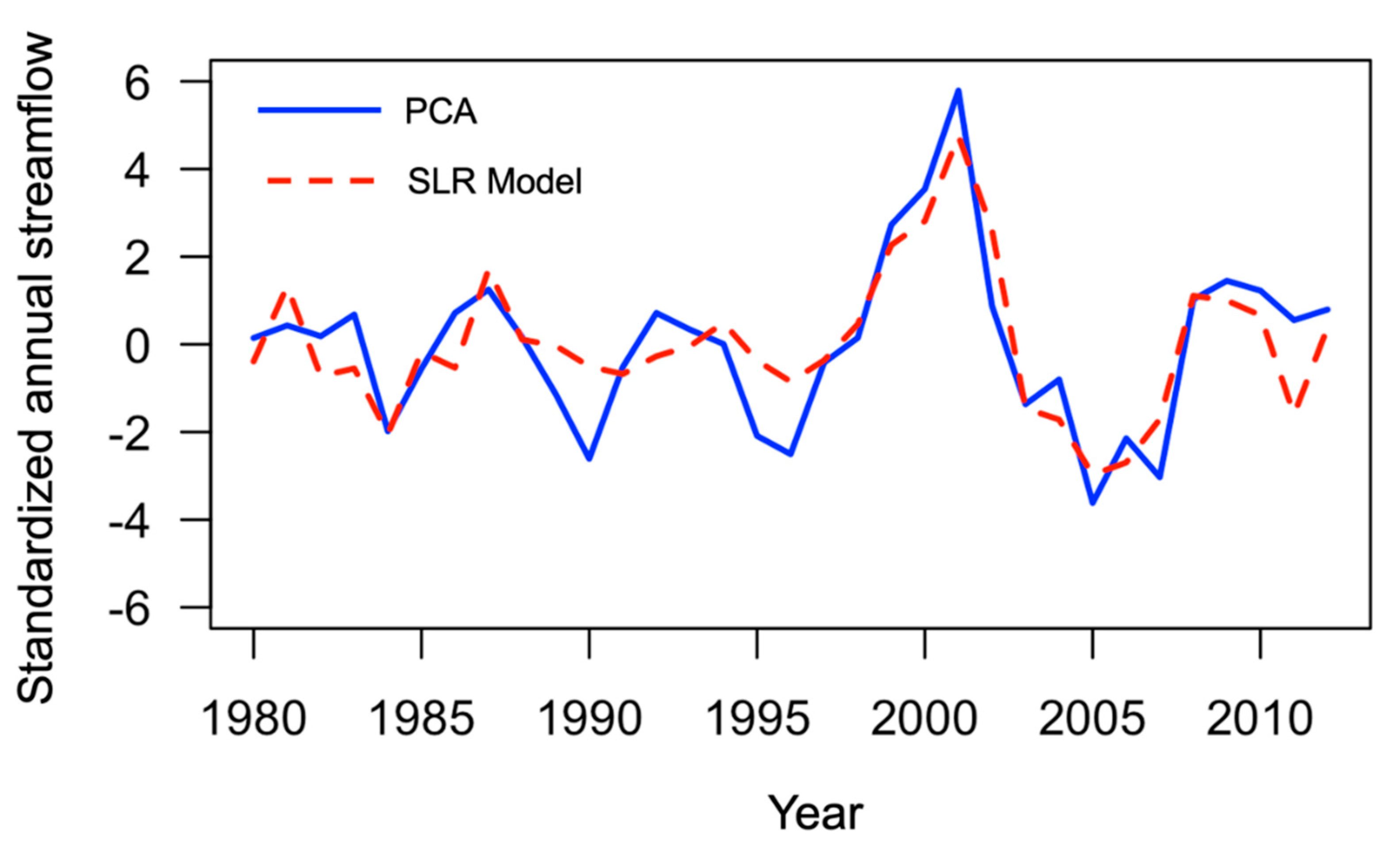

| Station | Lat, Lon | R2 | R2—Predicted | VIF | Durbin-Watson | Sign Test | R2 | Regression Equation |
|---|---|---|---|---|---|---|---|---|
| Adige/Etsch—Toll | 46.6764° N, 11.0835° E | 0.58 | 0.49 | 1.1 (pass) | 1.95 (pass) | 18/15 (pass) | 85% | Q = 32.958 + 1.644(70) + 1.060(98) |
| Adige/Etsch—Sigmundskron | 46.4856° N, 11.2988° E | 0.64 | 0.58 | 1.1 (pass) | 1.42 (pass) | 17/16 (pass) | 93% | Q = 53.8 + 2.26(81) + 2.19(154) |
| Adige/Etsch—Branzoll | 46.4040° N, 11.3206° E | 0.74 | 0.69 | 1.1 (pass) | 1.70 (pass) | 17/16 (pass) | 96% | Q = 139.55 + 4.7(81) + 6.9(154) |
| Rienz—Vintl | 46.8167° N, 11.7230° E | 0.65 | 0.59 | 1.4 (pass) | 1.64 (pass) | 18/15 (pass) | 88% | Q = 42.628 + 0.972(70) + 1.568(154) |
| Regional—PCA | N/A | 0.73 | 0.66 | 1.1 (pass) | 1.69 (pass) | 14/19 (pass) | N/A | Q = −0.191 + 0.326(81) + 0.252(84) + 0.5288(154) |
| Period | 1-Year | 5-Year | 10-Year | 20-Year | 30-Year |
|---|---|---|---|---|---|
| 0 to 100 | |||||
| 100 to 101 | |||||
| 201 to 300 | |||||
| 301 to 400 | 375 (2) | ||||
| 401 to 500 | 485 (3) | ||||
| 501 to 600 | |||||
| 601 to 700 | 619 (4) | ||||
| 701 to 800 | |||||
| 801 to 900 | |||||
| 901 to 1000 | 988–969 (5) | ||||
| 1001 to 1100 | 1078–1069 (5) | 1079–1060 (2) | 1087–1058 (2) | ||
| 1101 to 1200 | 1102 (1) | 1106–1102 (3) 1167–1163 (1) | 1170–1161 (1) 1108–1099 (4) | 1179–1160 (3) | 1185–1156 (5) |
| 1201 to 1300 | |||||
| 1301 to 1400 | 1397–1393 (2) | 1397–1388 (2) | |||
| 1401 to 1500 | 1505–1501 (5) | 1419–1390 (3) 1474–1445 (4) | |||
| 1501 to 1600 | 1540 (11) (* 2) | ||||
| 1601 to 1700 | 1669 (100) (* 21) | ||||
| 1701 to 1800 | |||||
| 1801 to 1900 | 1836–1832 (4) | 1844–1835 (3) | 1821–1802 (4) 1851–1832 (1) | 1861–1832 (1) | |
| 1901 to 2012 | 1921 (5) (* 1) |
Publisher’s Note: MDPI stays neutral with regard to jurisdictional claims in published maps and institutional affiliations. |
© 2021 by the authors. Licensee MDPI, Basel, Switzerland. This article is an open access article distributed under the terms and conditions of the Creative Commons Attribution (CC BY) license (https://creativecommons.org/licenses/by/4.0/).
Share and Cite
Formetta, G.; Tootle, G.; Bertoldi, G. Streamflow Reconstructions Using Tree-Ring Based Paleo Proxies for the Upper Adige River Basin (Italy). Hydrology 2022, 9, 8. https://doi.org/10.3390/hydrology9010008
Formetta G, Tootle G, Bertoldi G. Streamflow Reconstructions Using Tree-Ring Based Paleo Proxies for the Upper Adige River Basin (Italy). Hydrology. 2022; 9(1):8. https://doi.org/10.3390/hydrology9010008
Chicago/Turabian StyleFormetta, Giuseppe, Glenn Tootle, and Giacomo Bertoldi. 2022. "Streamflow Reconstructions Using Tree-Ring Based Paleo Proxies for the Upper Adige River Basin (Italy)" Hydrology 9, no. 1: 8. https://doi.org/10.3390/hydrology9010008
APA StyleFormetta, G., Tootle, G., & Bertoldi, G. (2022). Streamflow Reconstructions Using Tree-Ring Based Paleo Proxies for the Upper Adige River Basin (Italy). Hydrology, 9(1), 8. https://doi.org/10.3390/hydrology9010008








